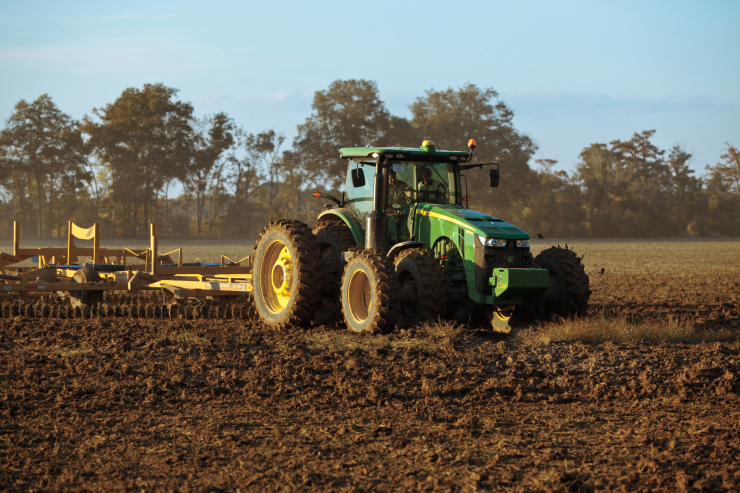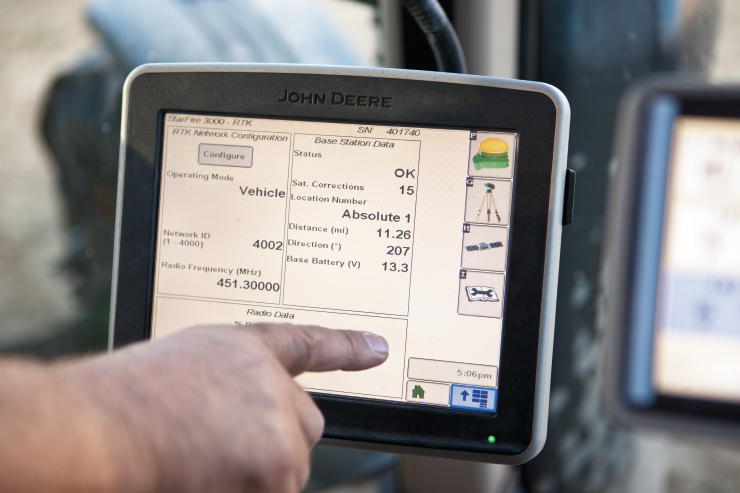Home > Mississippi > Mississippi Crops & Livestock > Rows of Soybean Success
Rows of Soybean Success
In partnership with: Mississippi Department of Agriculture and Commerce
 Mississippi’s landscape has transformed in the past decade. Urban acres aren’t the only areas seeing change, crops that grow on farms across the state have evolved as well. Where cotton used to lead the charge, many farmers have turned to corn and soybeans. “We don’t have the number of cotton gins in this state, but our grain elevators have picked up and expanded,” says Trent Irby, soybean specialist at Mississippi State University’s Agriculture Extension Service. “Driving down the road, it’s corn and soybeans everywhere you look.” The numbers don’t lie: soybeans have climbed to the top of Mississippi’s list of leading crops. Soybeans grow in more than half of the cultivated cropland in Mississippi. A 2012 survey by the U.S. Department of Agriculture estimates 2.1 million acres of soybeans are grown in Mississippi, up from 1.4 million acres in 2002. Soybeans have long been part of the state’s agriculture landscape, but were previously grown more as a rotational crop than a primary contributor to the state economy. However, as the value of cotton decreases, many farmers have switched to soybeans to stay in business.
Mississippi’s landscape has transformed in the past decade. Urban acres aren’t the only areas seeing change, crops that grow on farms across the state have evolved as well. Where cotton used to lead the charge, many farmers have turned to corn and soybeans. “We don’t have the number of cotton gins in this state, but our grain elevators have picked up and expanded,” says Trent Irby, soybean specialist at Mississippi State University’s Agriculture Extension Service. “Driving down the road, it’s corn and soybeans everywhere you look.” The numbers don’t lie: soybeans have climbed to the top of Mississippi’s list of leading crops. Soybeans grow in more than half of the cultivated cropland in Mississippi. A 2012 survey by the U.S. Department of Agriculture estimates 2.1 million acres of soybeans are grown in Mississippi, up from 1.4 million acres in 2002. Soybeans have long been part of the state’s agriculture landscape, but were previously grown more as a rotational crop than a primary contributor to the state economy. However, as the value of cotton decreases, many farmers have switched to soybeans to stay in business.  The Value of Soybeans With the close river and barge access, Irby says Mississippi is well placed for exporting soybeans. Unlike the more traditional grain states, Mississippi has direct access to international ports and can move soybeans more quickly from field to elevator and elevator to ocean. Willard Jack’s farm is located between the Mississippi and Yazoo rivers, a prime spot for export with a product that international consumers prefer. “They can go down there and get out quicker, faster and cheaper than anyone else can,” Jack says. With his family and crew, Jack, of Belzoni, grows 3,000-3,500 acres per year of solely soybeans, depending on the year and the crop mix. In addition to that, they grow 2,200 acres of corn, 1,000 acres of cotton, 600-700 acres of rice and about 400 acres of wheat. “We’ve always grown a lot of soybeans,” Jack says. “We’re growing more corn and less cotton because of the price and more soybeans and less rice because of the price.”
The Value of Soybeans With the close river and barge access, Irby says Mississippi is well placed for exporting soybeans. Unlike the more traditional grain states, Mississippi has direct access to international ports and can move soybeans more quickly from field to elevator and elevator to ocean. Willard Jack’s farm is located between the Mississippi and Yazoo rivers, a prime spot for export with a product that international consumers prefer. “They can go down there and get out quicker, faster and cheaper than anyone else can,” Jack says. With his family and crew, Jack, of Belzoni, grows 3,000-3,500 acres per year of solely soybeans, depending on the year and the crop mix. In addition to that, they grow 2,200 acres of corn, 1,000 acres of cotton, 600-700 acres of rice and about 400 acres of wheat. “We’ve always grown a lot of soybeans,” Jack says. “We’re growing more corn and less cotton because of the price and more soybeans and less rice because of the price.”  Changes in Growing Scientists and farmers are always testing different seeds to determine how to grow the best crops, but one of the biggest changes affecting soybean yield came from planting earlier. In 2012, 50 percent of the soybean crop was planted by the end of April and what wasn’t, rotated behind winter wheat and had to wait. The early planting allows the soybeans to grow before insects descend in late summer and avoids the typical August drought. That’s what Jack has learned in his years growing soybeans in the Delta. He started growing soybeans there in 1980 after moving from Canada, where he’d been growing the crop for nearly a decade. The climate, chance for a larger box of land and quality infrastructure encouraged him to move south. In the years he has built up the farm, Jack has seen vast changes in local farming practices. Many of the soybeans today are irrigated and he says they’ve adopted a lot of new technologies, such as changing seed varieties to better suit the conditions. “Now, we get everything ready in the fall and plant early in the spring and harvest early in the fall,” he says. With the change to earlier planting, Jack says he saw a dramatic increase in yield and was able to avoid expensive irrigation during late summer. Harvesting earlier also prevented the late-summer insect damage and it was easier to harvest when it’s dry. “We just do a better job overall of raising a better crop,” he says.
Changes in Growing Scientists and farmers are always testing different seeds to determine how to grow the best crops, but one of the biggest changes affecting soybean yield came from planting earlier. In 2012, 50 percent of the soybean crop was planted by the end of April and what wasn’t, rotated behind winter wheat and had to wait. The early planting allows the soybeans to grow before insects descend in late summer and avoids the typical August drought. That’s what Jack has learned in his years growing soybeans in the Delta. He started growing soybeans there in 1980 after moving from Canada, where he’d been growing the crop for nearly a decade. The climate, chance for a larger box of land and quality infrastructure encouraged him to move south. In the years he has built up the farm, Jack has seen vast changes in local farming practices. Many of the soybeans today are irrigated and he says they’ve adopted a lot of new technologies, such as changing seed varieties to better suit the conditions. “Now, we get everything ready in the fall and plant early in the spring and harvest early in the fall,” he says. With the change to earlier planting, Jack says he saw a dramatic increase in yield and was able to avoid expensive irrigation during late summer. Harvesting earlier also prevented the late-summer insect damage and it was easier to harvest when it’s dry. “We just do a better job overall of raising a better crop,” he says.  The Future of Soybeans But he knows that didn’t come easy. The farmers who ventured into soybeans decades ago worked to raise yields and looked at what would improve the industry. That has included new seed treatments and insect resistance that prove more valuable for farmers in Mississippi who have bigger problems with seed rot and insects compared to their northern counterparts. “It didn’t just happen,” Jack says. “Thirty to 40 years ago, they had a vision of what we needed to have soybeans profitable in the future.” Increased yields have made the area a low-cost producer and created an industry Jack sees as growing in the future. “As long as we have 60 percent to 70 percent yield potential on irrigated soybeans, we’re hard to compete with,” he says.
The Future of Soybeans But he knows that didn’t come easy. The farmers who ventured into soybeans decades ago worked to raise yields and looked at what would improve the industry. That has included new seed treatments and insect resistance that prove more valuable for farmers in Mississippi who have bigger problems with seed rot and insects compared to their northern counterparts. “It didn’t just happen,” Jack says. “Thirty to 40 years ago, they had a vision of what we needed to have soybeans profitable in the future.” Increased yields have made the area a low-cost producer and created an industry Jack sees as growing in the future. “As long as we have 60 percent to 70 percent yield potential on irrigated soybeans, we’re hard to compete with,” he says.



